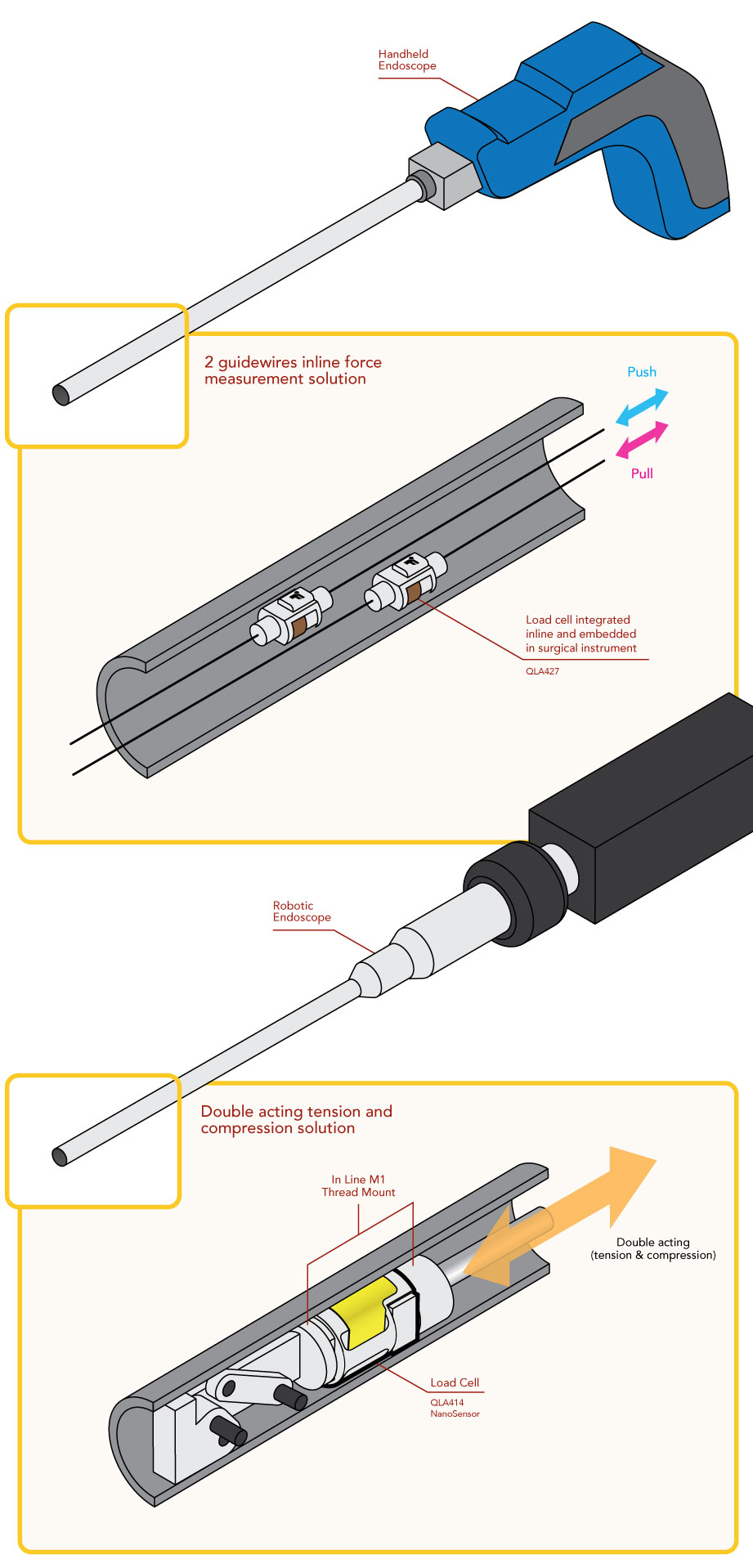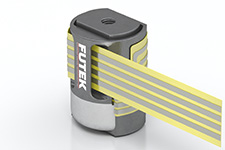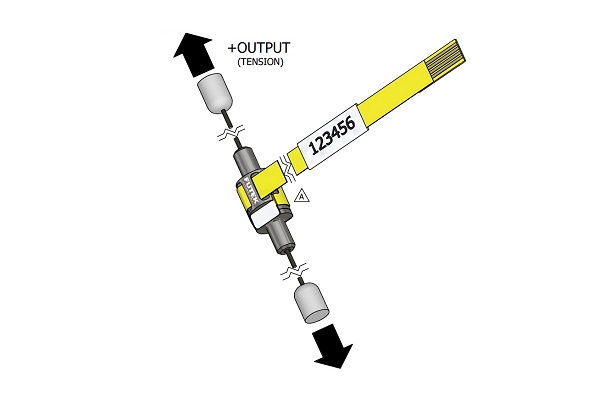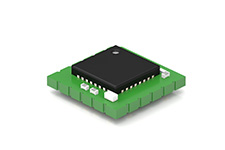The challenge: measuring endoscope motion forces
Endoscopes allow doctors to see inside the patient to find anomalies during diagnostic, laparoscopic, or exploratory procedures. The movement of these devices are wire driven and provide little to no haptic feedback. This requires extensive training so that the operator can learn to judge applied force visually. Making the controls more intuitive to improve operator fidelity requires a force measurement system that can survive sterilization processes. This involves autoclavable in-line load cells installed inline with the control wires to create a haptic feedback control system for the endoscope.
Biocompatibility, Sterilization & Autoclavability: Sensor must survive high temp & pressure
The embedded sensor must follow standard sterilization used for surgical instruments. Sterilization protocol in an autoclave determines 121 °C and 205 kPa steam for 4 to 15 minutes. Bonding agents, microelectronic components, strain gauges, and electrical conductors must be able to withstand these temperatures and pressures.
Commercially available robotic surgical systems that are modular in design allow being reutilized approximately 12 to 20 times.
Hermeticity of high precision sub-miniature load sensing elements is equally challenging. The conventional approach to sealing electronic components is the adoption of conformal coatings, which is not suitable for high-reliability medical, reusable and sterilizable solutions. An alternative is to weld on a header interface to the sensor. Again, welding faces obstacles in miniaturized sensors due to its size constraints. All in all, a novel and robust approach is a monolithic sensor using custom formulated, Ct matched, chemically neutral, high temperature fused isolator technology used to feed electrical conductors through the walls of the hermetically sealed active sensing element. The fused isolator technology has shown reliability in the hundreds to thousands of autoclave cycles.
Why FUTEK NanoSensors are up to the challenge
The design and manufacture of a force sensor for robotic endoscopes entail two distinct but complementary challenges: overcoming technical obstacles of designing a miniaturized medical sensor (miniaturization, biocompatibility, autoclavability, and high reusability) while maintaining the minimally required specification of a high-grade force measurement solution (nonlinearity, hysteresis, repeatability, cross-talk, bandwidth, and noise-free resolution).
The FUTEK’s NanoSensor was engineered with all these design constraints in mind as well as Design for Manufacturability (DFM) approach.
QLA414 Nano Force Sensor is the smallest tension and compression force measurement solution of its kind (micro-miniature in-line load cell). The 4mm x 5mm Nano Force sensor, opens up a world of possibilities for industries such as advanced automation, semiconductor, electronics assembly, robot gripping force measurement, and robotic surgery, where force sensor size is critical.
The QLA414 Nano Force Sensor features M1 threaded double-sided mounting provisions and a unique thru-hole design allowing for flexible slide-on, weld-on over the tube, wire, or shaft integration options. Nano Sensors multi-element, side load compensated 1000 Ohm full-bridge instrumentation is encased with laser-welded construction with patent-pending non-active interconnect packaging providing environmental protection. It allows for high accuracy in 5lb and 10lb capacities with ultra-low deflection, and high natural frequency response up to 98KHz.
Additionally, force sensors as small as 3mm x 4mm with force measurement capabilities up to 50lb, are also available for OEM applications, including IP67 and autoclavable sensors for the medical industry. Being the ideal miniature load cell for surgical robotics and laparoscopic grasper with force perception, the NANO Force Transducer is well suited for haptics force feedback and catheter ultra-miniature load cell.
QLA414 Features
- M1 threaded double-sided mounting provisions;
- 1000 Ohm full-bridge side load (off axis or extraneous loads) compensated instrumentation;
- Laser-welded construction;
- Non-active interconnect;
- Environmental protection;
- ±0.5% nonlinearity of rated output (RO) in 5lb and 10lb capacities - high precision force measurement applications;
- Up to 200% safe overload;
- Tension and compression force sensor;
- Ultra-low deflection (0.0002” [0.005 mm]);
- High natural frequency response.
How it Works
Two Nano Force Sensors are installed in-line with the cables controlling the endoscope's motion, or alternatively, threaded mounted with the actuating shaft.
As the endoscope is moved, the load cells measure the force required to move the insertion tube and the distal end (i.e. head).
The force measurement signal is read by QIA128 is a miniature ultra low power digital signal conditioner with SPI output and can be used for system integration. It enables appropriate force feedback in the surgeon's hand controls.
The load cells are designed to survive the high pressure, temperature, and PH sterilization environments needed to meet ISO/TC 198 standards and IP69K rating.
Load cell data captured by instrumentation can then be repurposed to further refine controls and used for traceability requirements.
Products in Use
Contact Us
All FUTEK application illustrations are strictly conceptual.
Please Contact Us with questions.
Please Contact Us with questions.
The challenge: measuring endoscope motion forces
Endoscopes allow doctors to see inside the patient to find anomalies during diagnostic, laparoscopic, or exploratory procedures. The movement of these devices are wire driven and provide little to no haptic feedback. This requires extensive training so that the operator can learn to judge applied force visually. Making the controls more intuitive to improve operator fidelity requires a force measurement system that can survive sterilization processes. This involves autoclavable in-line load cells installed inline with the control wires to create a haptic feedback control system for the endoscope.
Biocompatibility, Sterilization & Autoclavability: Sensor must survive high temp & pressure
The embedded sensor must follow standard sterilization used for surgical instruments. Sterilization protocol in an autoclave determines 121 °C and 205 kPa steam for 4 to 15 minutes. Bonding agents, microelectronic components, strain gauges, and electrical conductors must be able to withstand these temperatures and pressures.
Commercially available robotic surgical systems that are modular in design allow being reutilized approximately 12 to 20 times.
Hermeticity of high precision sub-miniature load sensing elements is equally challenging. The conventional approach to sealing electronic components is the adoption of conformal coatings, which is not suitable for high-reliability medical, reusable and sterilizable solutions. An alternative is to weld on a header interface to the sensor. Again, welding faces obstacles in miniaturized sensors due to its size constraints. All in all, a novel and robust approach is a monolithic sensor using custom formulated, Ct matched, chemically neutral, high temperature fused isolator technology used to feed electrical conductors through the walls of the hermetically sealed active sensing element. The fused isolator technology has shown reliability in the hundreds to thousands of autoclave cycles.
Why FUTEK NanoSensors are up to the challenge
The design and manufacture of a force sensor for robotic endoscopes entail two distinct but complementary challenges: overcoming technical obstacles of designing a miniaturized medical sensor (miniaturization, biocompatibility, autoclavability, and high reusability) while maintaining the minimally required specification of a high-grade force measurement solution (nonlinearity, hysteresis, repeatability, cross-talk, bandwidth, and noise-free resolution).
The FUTEK’s NanoSensor was engineered with all these design constraints in mind as well as Design for Manufacturability (DFM) approach.
QLA414 Nano Force Sensor is the smallest tension and compression force measurement solution of its kind (micro-miniature in-line load cell). The 4mm x 5mm Nano Force sensor, opens up a world of possibilities for industries such as advanced automation, semiconductor, electronics assembly, robot gripping force measurement, and robotic surgery, where force sensor size is critical.
The QLA414 Nano Force Sensor features M1 threaded double-sided mounting provisions and a unique thru-hole design allowing for flexible slide-on, weld-on over the tube, wire, or shaft integration options. Nano Sensors multi-element, side load compensated 1000 Ohm full-bridge instrumentation is encased with laser-welded construction with patent-pending non-active interconnect packaging providing environmental protection. It allows for high accuracy in 5lb and 10lb capacities with ultra-low deflection, and high natural frequency response up to 98KHz.
Additionally, force sensors as small as 3mm x 4mm with force measurement capabilities up to 50lb, are also available for OEM applications, including IP67 and autoclavable sensors for the medical industry. Being the ideal miniature load cell for surgical robotics and laparoscopic grasper with force perception, the NANO Force Transducer is well suited for haptics force feedback and catheter ultra-miniature load cell.
QLA414 Features
- M1 threaded double-sided mounting provisions;
- 1000 Ohm full-bridge side load (off axis or extraneous loads) compensated instrumentation;
- Laser-welded construction;
- Non-active interconnect;
- Environmental protection;
- ±0.5% nonlinearity of rated output (RO) in 5lb and 10lb capacities - high precision force measurement applications;
- Up to 200% safe overload;
- Tension and compression force sensor;
- Ultra-low deflection (0.0002” [0.005 mm]);
- High natural frequency response.





